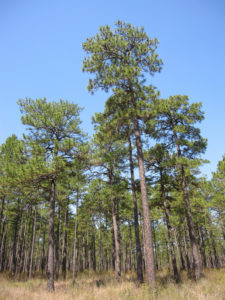We have much more to do and your continued support is needed now more than ever.
Longleaf Pine Restoration Included in New Era of Conservation
USDA made an announcement last week that will help NWF’s work on longleaf pine restoration in the southeast. Farm Bill funds will provide support to partners exploring the economics and incentives for increasing the acreage of sustainable, working forests on private lands in the southeast.
NWF Working to Protect Forests and Wildlife
NWF’s Southeast Forestry Program is dedicated to projects that protect and restore forests and wildlife habitats throughout the region, and longleaf pine restoration remains a keystone to our program and our affiliates. Since 2007, we have worked with the Alabama Wildlife Federation to plant, manage, and restore over 9,000 acres of longleaf pine forests on private lands. This program is important to us and the landowners we work with, as longleaf pine provides income through sustainable timber practices, recreational purposes (i.e. quality hunting habitat, bird watching), aesthetics as it is a beautiful ecosystem with a vibrant understory, and has meaningful cultural and intrinsic values to the southeast.

Longleaf Pine Forests Provide Excellent Wildlife Habitat
Longleaf pine forests provide an ideal habitat for wildlife due to the high level of biodiversity found in the ecosystem, as longleaf provides crucial components needed for wildlife survival such as food, water, cover and space. Wildlife species found in longleaf pine forests include the northern bobwhite quail, red-cockaded woodpeckers, gopher tortoises, striped newts, pinewoods treefrogs, pine and prairie warblers, eastern indigo snakes, Bachman’s sparrows, white-tailed deer, the Eastern wild turkey and many more. Twenty-nine species on the Federal threatened or endangered lists are found in these forests, however these pine forests are one of the most endangered landscapes in North America. Balancing economic, ecological and social values is crucial to restoration goals and is recognized by the federal government, private companies, and conservation organizations alike.
Farm Bill Funds for Conservation
On January 14 the Secretary of Agriculture, Tom Vilsack, announced that two projects in the Longleaf Pine Range were selected to receive Regional Conservation Partnership Program (RCPP) funds from the 2014 Farm Bill, marking a historic inclusion of the southeastern forest species in federal conservation efforts. The Longleaf Pine Range was recently declared a Critical Conservation Area (CCA) by Vilsack; this is significant to NWF and partners as it shows the federal commitment to support projects that elevate longleaf restoration throughout the southeast.

Focusing on Forests
I applaud the USDA in their inclusion of the longleaf pine range and the two projects selected as recipients of federal conservation funding, and hope to see additional programs and projects aimed at sustaining forest habitats such as longleaf pine funded in the future. Forest restoration and wildlife habitat are distinctly and highly integrated; the longleaf pine forest is an exemplary model of a species deserving of conservation efforts and initiatives underway to restore these forests and consequently, wildlife.






















